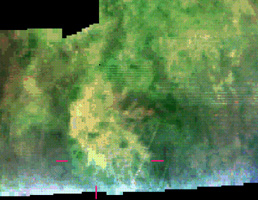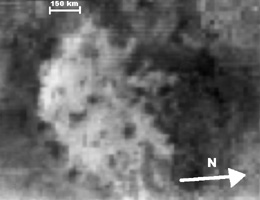 |  |
Figure 1
Click on image for larger resolution | Labeled Image
Click on image for larger resolution |
This infrared image taken by the visual and infrared mapping spectrometer on NASA's Cassini spacecraft shows Hotei Arcus, a region on Saturn's moon Titan where changes in brightness have been measured several times during the last four years.
The brightness variations, combined with flow-like morphology seen in higher resolution Cassini radar images, suggest that Hotei Arcus may be the site of current activity, possibly an ice volcano. If so, it would be the first active cryovolcano to be observed on Titan. The red markings in the false color image (Figure 1) indicate a region that is chemically distinct from its surroundings, which may correspond to the most recent location of activity.
Visual and infrared mapping spectrometer scientists also report the brightness changes are consistent with transient deposits of ammonia frost on Titan's surface, although other materials cannot be ruled out. Ammonia is generally believed to be an important component in the interior of Titan. The association of ammonia with brightening in this region would further suggest that Hotei Arcus is presently a center of activity.
This image was taken at a distance of 29,000 kilometers (18,000 miles) on Nov. 19, 2008.
The Cassini-Huygens mission is a cooperative project of NASA, the European Space Agency and the Italian Space Agency. The Jet Propulsion Laboratory, a division of the California Institute of Technology in Pasadena, manages the mission for NASA's Science Mission Directorate, Washington, D.C. The Cassini orbiter was designed, developed and assembled at JPL. The visual and infrared mapping spectrometer team is based at the University of Arizona.
For more information about the Cassini-Huygens mission visit http://saturn.jpl.nasa.gov/home/index.cfm. The visual and infrared mapping spectrometer team homepage is at http://wwwvims.lpl.arizona.edu.

